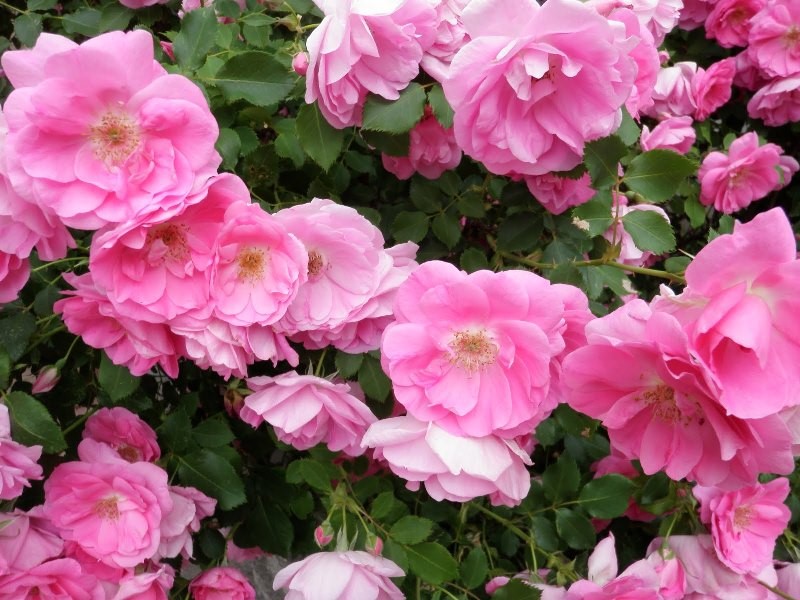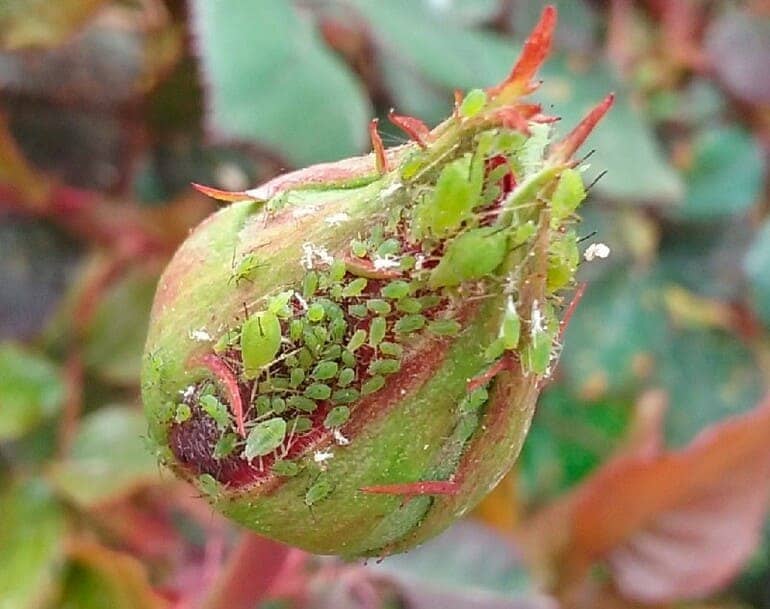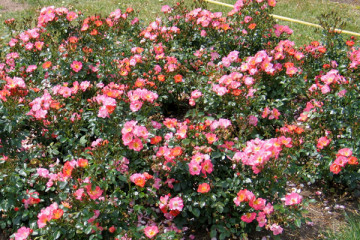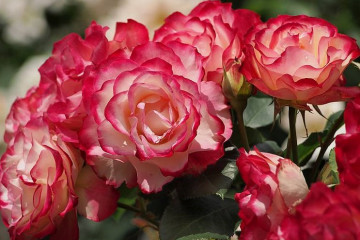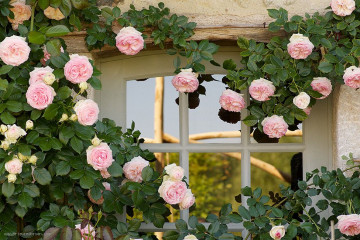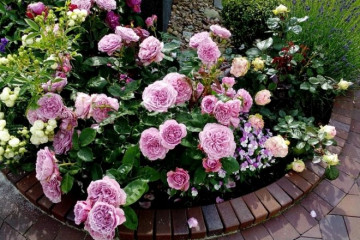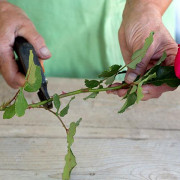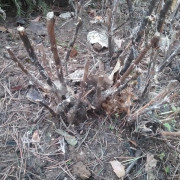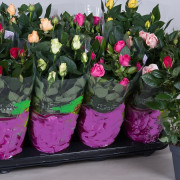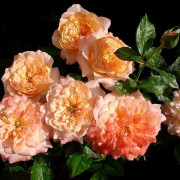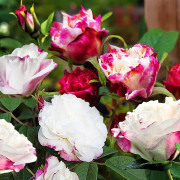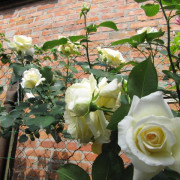Rose Morden Sunrise - characteristics of the variety
Content:
Park roses differ from other types of long and lush flowering. In addition to beauty, some varieties are famous for their high frost resistance. One of them is Morden Sunrise.
Rose Morden Sunrise - what is this variety
Rose Morden Sunrise - the first winter hardy yellow rose of the Canadian selection. Bred in 1999 in Canada specifically for growing in regions with cold climates. The variety opened a series of garden and park roses.
Rose Canadian park Moden Sunrise has sprawling erect bushes, reaching up to 70 cm in height. Flowers with a diameter of 8-10 cm have a yellow or orange color, yellowish tints appear in cold or rainy seasons (varieties of the variety may have a different color). The flowers are terry, smell good, last up to two weeks, grow in clusters, on each of which 4-8 flowers can bloom. Leaves are shiny, dark green.
The description says that the main advantage of the variety is its frost resistance. Morden Sunrise Canadian roses are able to withstand up to -45 ° C and are not afraid of temperature changes. Other benefits:
- long flowering;
- variety of colors;
- disease resistance.
Roses are used in landscape design: they decorate the borders of a flower garden, beat off curbs and lawns. Roses will make a beautiful hedge.
Growing a flower
Morden Sunrise does not require special care, but some subtleties of planting and care must be observed. Plant a rose with seedlings. When buying them, pay attention that the trunk is strong with a long stable leg and always with roots.
Planting should be done in the fall. So, over the winter, the roots will get stronger, and in the spring the bush will be able to please with its appearance.
Seat selection
The rose feels comfortable both in the sun and in partial shade. Although the flower loves abundant lighting, its overabundance will not be useful, so it is better to plant in a well-ventilated place with a little shade.
The soil is loose and not acidic. It would be nice to fertilize it with mineral fertilizers or peat, wood ash, humus.
A hole is dug with a diameter of 70-80 cm.The depth is calculated so that the seedling fits 5-10 cm by the roots.
Planting procedure step by step
How to plant a seedling correctly:
- Dig a hole 70 cm in diameter.
- Add fertilizer in the form of compost, peat or complex composition.
- Plant a seedling, deepening it by 5-10 cm.
- Sprinkle with earth, compact slightly.
- Spud the seedling and water.
Plant care
Care rules are simple:
- the variety grows well in drought, but watering is desirable at high temperatures;
- any soil is suitable for this variety;
- feeding is carried out twice: in the spring (with nitrogen) and in the summer (with phosphorus);
- you do not need to cut the bush to give a decorative look, it already looks beautiful. But after winter, the broken, frozen stems must be removed. Faded buds are also removed. When the bush fades, remove all dry residues and cut off the stems that have not given buds.
Features of wintering a flower
The need for shelter depends on the place of growth: in the southern regions, sheltering flowers for the winter is not necessary, but in the northern regions it will not be superfluous. In the northern regions, winters are tougher: the frozen bush will recover until mid-summer and, accordingly, will not bloom before full recovery.
Before hibernation, cut those stems that easily break the thorns.
If the bush is young, it is advisable to cover it for the winter: sprinkle the ground with peat or humus, and wrap the stems in paper. This will protect them from freezing.
Blooming rose
Morden Sunrise blooms all summer, and with proper care until the very frost. If in the spring before flowering the roses were well watered, then in the summer watering is necessary only in dry weather.
During the dormant period, cut off all inflorescences, cut off the stems. The plant stops growing.
What to do if it does not bloom
The lack of flowers on the bush can be explained by several reasons.
- Young or old bush. The quality of flowering directly depends not only on the conditions of detention, but also on the age of the flower. A rose that is too old will not have enough strength to bloom: the stems will become woody and will not be able to deliver nutrients to the tops of the stems. And the young have every right not to bloom at all in the first year. Therefore, it is recommended to remove all primroses until August, and then leave a few buds.
- Too much shadow. A lot of sun is bad, but little is also bad. Roses love the warmth of the sun. Due to a lack of light, the bush may not bloom for a long time.
- Competition on the site. Roses do not get along well with all types of cultures. Among the unsuitable neighbors are lilacs, spiraea and chubushnik. If they grow nearby, they will take nutrients from the rose.
- Improper care and illness. Frequent watering and fertilization also leave their mark on the formation of buds, and in the presence of diseases or pests, you should not wait for flowers at all.
Flower propagation
The rose is propagated in three ways: by dividing the bush, cuttings and lateral branches. The time of the procedure depends on the method.
- The division of the bush is spring.
- Reproduction by lateral branches - spring.
- Cuttings - autumn, spring.
The division of the bush is carried out in the spring. To do this, the entire rose bush is carefully dug out of the ground and divided into several parts using a sharp pruner. Finished plots are planted in holes and watered. It is also advisable to huddle seedlings.
Many growers carry out cuttings in the fall. Each stalk should be at least 10 cm. The cut branches are wrapped in peat and plastic wrap. In this form, the cuttings are stored all winter. The best place is a refrigerator or a cellar.
You can also cut the cuttings in the spring and immediately plant them in the open ground, or you can put them in a container with water until the roots form. The main thing is to change the water regularly.
Reproduction by lateral branches is carried out as follows: the lateral stems of the bush are bent to the ground. Approximately the middle of the stem is carefully buried in the hole, after making cuts in this place, and then everything is watered abundantly.
Before winter, the root system will have to grow and strengthen, but if the roots are still weak, the bends are covered with polyethylene for the winter.
Diseases, pests and ways to control them
Of the possible diseases of roses, the most common are spheroteka and powdery mildew. As a preventive measure, in the spring, the rose is sprayed with a solution of ferrous sulfate or fungicides.
From insects that infect the vegetative parts of the plant, there are:
- weevil;
- aphids;
- spider mite;
- garden beetle.
To prevent the appearance of insects, it is necessary to regularly loosen the soil and remove weeds, as well as prevent waterlogging of the soil. If the bush is already infected with it, it is sprayed with insecticides - actofil or phytoverm.
Rose Sunrise does not require special care, it is resistant to pests and diseases. By taking good care of the plant on a regular basis, you can get beautiful bouquets of flowers in return as a reward for caring.

